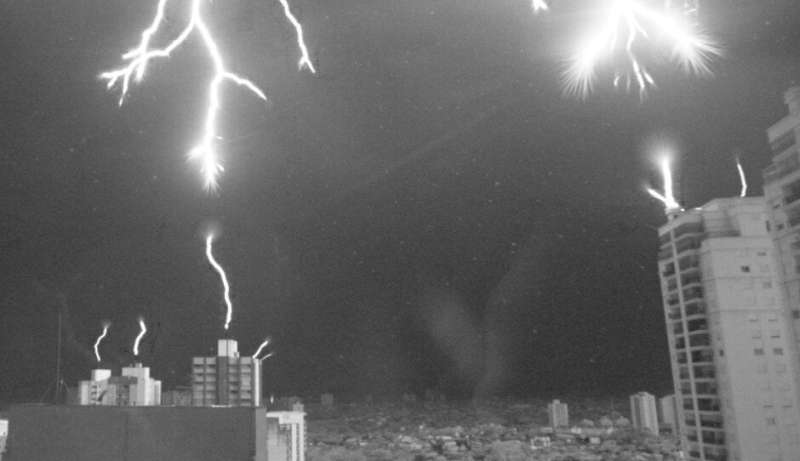[…] “The image was captured on a summer evening in São José dos Campos [in São Paulo state] while a negatively charged lightning bolt was nearing the ground at 370 km per second. When it was a few dozen meters from ground level, lightning rods and tall objects on the tops of nearby buildings produced positive upward discharges, competing to connect to the downward strike. The final image prior to the connection was obtained 25 thousandths of a second before the lightning hit one of the buildings,” Saba said.
He used a camera that takes 40,000 frames per second. When the video is played back in slow motion, it shows how lightning discharges behave and also how dangerous they can be if the protection system is not properly installed: Although there are more than 30 lightning rods in the vicinity, the strike connected not to them but to a smokestack on top of one of the buildings. “A flaw in the installation left the area unprotected. The impact of a 30,000-amp discharge did enormous damage,” he said.
[…]
Lightning strikes branch out as the electrical charges seek the path of least resistance, rather than the shortest path, which would be a straight line. The path of least resistance, usually a zigzag, is determined by different electrical characteristics of the atmosphere, which is not homogeneous. “A lightning strike made up of several discharges can last up to 2 seconds. However, each discharge lasts only fractions of milliseconds,” Saba said.
Lightning rods neither attract nor repel strikes, he added. Nor do they “discharge” clouds, as used to be believed. They simply offer lightning an easy and safe route to the ground.
Because it is not always possible to rely on the protection of a lightning rod, and most atmospheric discharges occur in summer in the tropics, it is worth considering Saba’s advice. “Storms are more frequent in the afternoon than in the morning, so be careful about outdoor activities on summer afternoons. Find shelter if you hear thunder, but never under a tree or pole, and never under a rickety roof,” he said.
“If you can’t find a safe place to shelter, stay in the car and wait for the storm to blow over. If no car or other shelter is available, squat down with your feet together. Don’t stand upright or lie flat. Indoors, avoid contact with appliances and fixed-line telephones.”
It is possible to survive being struck by lightning, and there are many examples. The odds increase if the person receives care quickly. “Cardiac arrest is the only cause of death. In this case, cardiopulmonary resuscitation is the recommended treatment,” Saba said.
Saba began systematically studying lightning with high-speed cameras in 2003, ever since building a collection of videos of lightning filmed at high speed that has become the world’s largest.
More information: Marcelo M. F. Saba et al, Close View of the Lightning Attachment Process Unveils the Streamer Zone Fine Structure, Geophysical Research Letters (2022). DOI: 10.1029/2022GL101482
Source: Unique image obtained by scientists with high-speed camera shows how lightning rods work

Robin Edgar
Organisational Structures | Technology and Science | Military, IT and Lifestyle consultancy | Social, Broadcast & Cross Media | Flying aircraft

